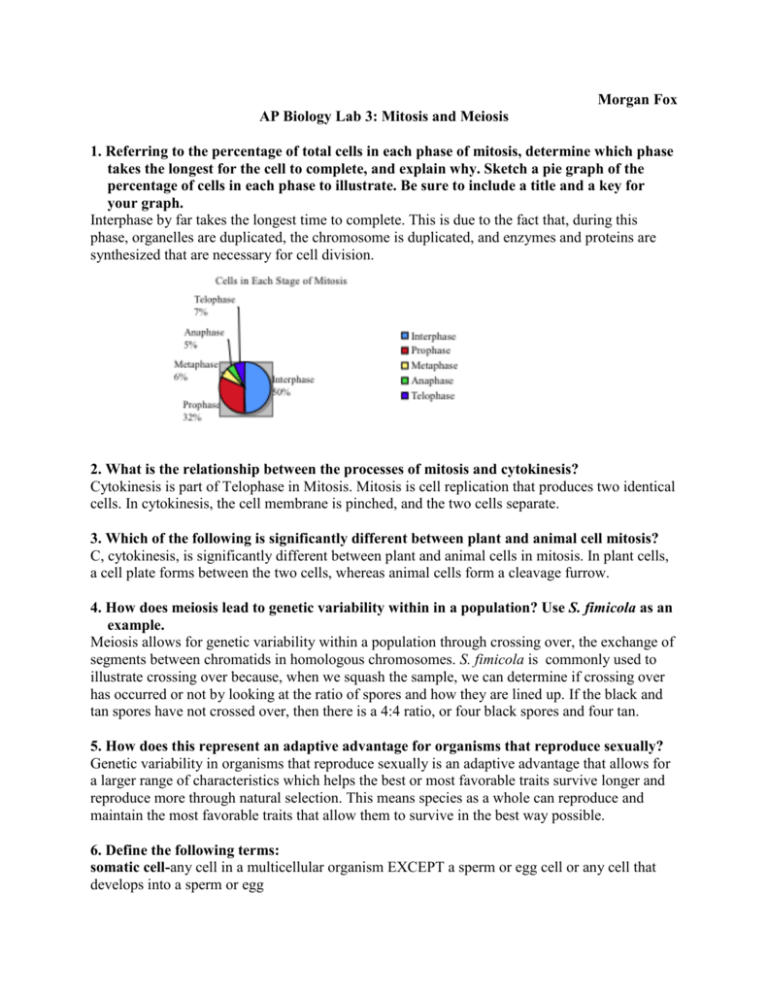File
advertisement

Morgan Fox AP Biology Lab 3: Mitosis and Meiosis 1. Referring to the percentage of total cells in each phase of mitosis, determine which phase takes the longest for the cell to complete, and explain why. Sketch a pie graph of the percentage of cells in each phase to illustrate. Be sure to include a title and a key for your graph. Interphase by far takes the longest time to complete. This is due to the fact that, during this phase, organelles are duplicated, the chromosome is duplicated, and enzymes and proteins are synthesized that are necessary for cell division. 2. What is the relationship between the processes of mitosis and cytokinesis? Cytokinesis is part of Telophase in Mitosis. Mitosis is cell replication that produces two identical cells. In cytokinesis, the cell membrane is pinched, and the two cells separate. 3. Which of the following is significantly different between plant and animal cell mitosis? C, cytokinesis, is significantly different between plant and animal cells in mitosis. In plant cells, a cell plate forms between the two cells, whereas animal cells form a cleavage furrow. 4. How does meiosis lead to genetic variability within in a population? Use S. fimicola as an example. Meiosis allows for genetic variability within a population through crossing over, the exchange of segments between chromatids in homologous chromosomes. S. fimicola is commonly used to illustrate crossing over because, when we squash the sample, we can determine if crossing over has occurred or not by looking at the ratio of spores and how they are lined up. If the black and tan spores have not crossed over, then there is a 4:4 ratio, or four black spores and four tan. 5. How does this represent an adaptive advantage for organisms that reproduce sexually? Genetic variability in organisms that reproduce sexually is an adaptive advantage that allows for a larger range of characteristics which helps the best or most favorable traits survive longer and reproduce more through natural selection. This means species as a whole can reproduce and maintain the most favorable traits that allow them to survive in the best way possible. 6. Define the following terms: somatic cell-any cell in a multicellular organism EXCEPT a sperm or egg cell or any cell that develops into a sperm or egg germ cell-the sexual reproductive cell at any stage from the primordial cell to the mature gamete chromatin-the combination of DNA and proteins that constitutes eukaryotic chromosomes; often used to refer to the diffuse, very extended form taken by chromosomes when a cell is not dividing centromere-the region of a duplicated chromosome where two sister chromatids are joined (often appearing as a narrow “waist”) and where spindle microtubules attach during mitosis and meiosis. It divides at the onset of anaphase during mitosis and anaphase II during meiosis diploid- in an organisms that reproduces sexually, a cell containing two homologous sets of chromosomes, one set inherited from each parent; a 2n cell haploid-in the life cycle of an organism that reproduces sexually, a cell containing a single set of chromosomes; an n cell zygote-the diploid fertilized egg, which results from the union of a sperm cell nucleus and an egg cell nucleus 7. Create a Venn diagram showing at least two similarities and two differences between mitosis and meiosis. 8. Why is S. fimicola an ideal organism for the demonstration of crossing-over? Not only is S. fimicola easily grown in an agar petri dish, but it also has distinct spore colors, depending on the type. S. fimicola is typically black, whereas mutant forms are grey or light brown. These easily differentiated spores make it easy for students to determine whether crossing-over has occurred or not because the pattern is easy to count when spore types can be easily distinguished. 9 When eukaryotic cells undergo mitosis, it results in two identical daughter cells, each with a nucleus. Prokaryotic cells are cells that do not contain a distinct nucleus. Research cell division in prokaryotic cell and compare and contrast it to division in eukaryotic cells. Cell division in prokaryotic cells is a much simpler process than in eukaryotic cells. In prokaryotes division is called binary fission. During this process, the chromosome (a single DNA molecule) replicates, and each molecule attaches to either side of the cell membrane. The process of the cell actually splitting is the same as in eukaryotes (cytokinesis). Mitosis, cell division in eukaryotic cells, has many complex steps (Interphase, Prophase, Metaphase, Anaphase, and Telophase) as there are actual chromosomes to separate and multiple organelles to replicate. Basically, the similarities between prokaryotic and eukaryotic cell division are the phases of Interphase and Telophase (Cytokinesis). 10. A classmate of yours was absent on the day the lab was performed. Come up with a list of materials (excluding pen and paper) you might use to visually demonstrate the concepts of mitosis, meiosis, and crossing-over. I could make homologous chromosomes out of play dough (as well as organelles) to show the divisions in mitosis and meiosis as well as the replication of organelles, using additional play dough in meiosis to represent the cleavage furrow/cell plate that forms. Since play dough breaks apart and reattaches easily, I would use this advantage to demonstrate the concept of crossingover.







